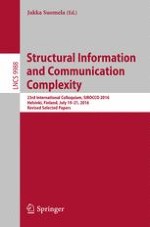2016 | OriginalPaper | Buchkapitel
Public vs. Private Randomness in Simultaneous Multi-party Communication Complexity
verfasst von : Orr Fischer, Rotem Oshman, Uri Zwick
Erschienen in: Structural Information and Communication Complexity
Aktivieren Sie unsere intelligente Suche, um passende Fachinhalte oder Patente zu finden.
Wählen Sie Textabschnitte aus um mit Künstlicher Intelligenz passenden Patente zu finden. powered by
Markieren Sie Textabschnitte, um KI-gestützt weitere passende Inhalte zu finden. powered by
